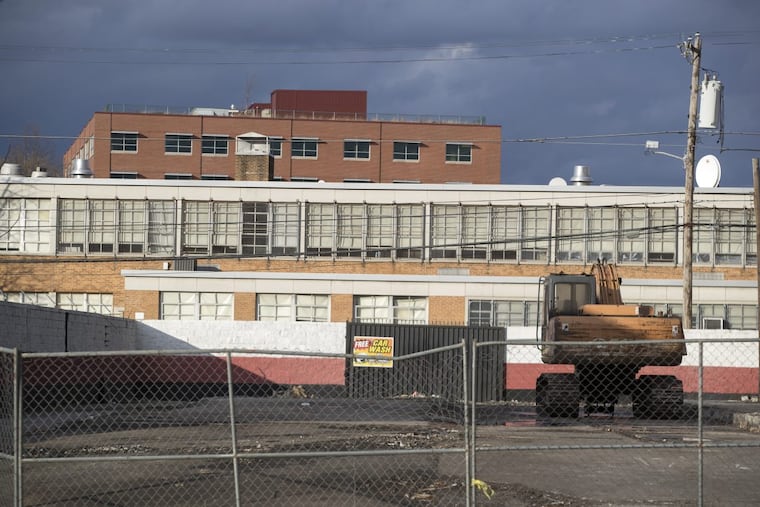Proposed West Philly apartments may sit atop an old graveyard
Not much is known about the cemetery that, according to historic maps, may lie beneath what was until recently a car wash.

A proposed West Philadelphia residential development could be poised to dig into an old cemetery and tangles of human bones, according to an alarm raised by the Philadelphia Archaeological Forum, a professional association.
The forum, concerned about appropriate treatment of abandoned historic graveyards, has discovered that a forgotten burial ground lies beneath the construction site proposed for 4125 Chestnut St., former home of Chestnut Wash 'n' Lube.
The forum is worried the site may eventually lead to the same kind of exposure of human remains that took place last year during building excavation at 218 Arch St. in Old City.
"Past experience in Philadelphia strongly suggests that there is a reasonably high expectation that development of that [Chestnut Street] site will result in the disturbance of intact human remains if appropriate steps are not taken in advance of demolition and construction," Douglas B. Mooney, president of the forum, wrote on Jan. 19 to David Perri, commissioner of the Department of Licenses and Inspections.
If archaeologists determine graves are present, the forum calls for the involvement of Orphans' Court, which has jurisdiction over abandoned graveyards.
L&I has issued permits for the apartment building, which has also gone through the Planning Commission's civic design review process. No mention of a historic graveyard surfaced with either L&I or the Planning Commission, officials said.
Demolition of the Wash 'n' Lube began this week, and by Tuesday evening, the buildings were gone, a turn of events the archaeological group was hoping to avoid.
Robert Minor of RJR Group of Philadelphia, the firm engaged in demolition, said Wednesday he had received no notification that a cemetery may have been on the site.
"We didn't hear anything about that," Minor said. He said the car wash had no basement. "We're just taking off across the top," he said.
The forum urged hiring an archaeological consultant before the start of demolition to determine whether there are any graves. If there are, the forum urges, the developer should petition Orphans' Court "to obtain permission to respectfully exhume and relocate those remains to another burial location."
The site is owned by an anonymous private real estate partnership in New York — 4125 Chestnut Street CRCP LLC. Planning Commission documents list Philadelphia contractor Vaughan Buckley, a specialist in modular construction, as lead project contractor.
Buckley said Wednesday his firm was looking into the matter. The company's general manager, Michael Pasharik, said Monday it was the first he'd heard of an old graveyard at the site.
L&I spokeswoman Karen Guss confirmed that the agency had received the archaeological forum's letter. "Folks are looking at it and trying to figure out an appropriate response," she said Monday.
Mooney, in an interview, said nothing was known about the graveyard, which appears on multiple historic maps, most recently in Bromley's 1895 and 1901 Atlases of Philadelphia.
No city agency requires developers to check historic atlases for potential cemetery conflicts, despite the fact that the problem arises regularly, often out of sight, but occasionally with considerable publicity. There is no city database of such sites.
"Nothing compels [the developer] to look, other than the fact that it could be a disaster," said Mooney. "It's ridiculous they're not required to do that."
That became clear when PMC Property Group began digging for its residential development in the 200 block of Arch Street in fall 2016.
That site was clearly marked on historic maps as the location of the old First Baptist Church burial ground. Almost immediately, the developer hit human remains.
By March, teams of volunteer archaeologists were swarming the site, racing bulldozers in a frantic effort to excavate countless coffins, which had supposedly been removed from the ground in 1860 and transported to Mount Moriah Cemetery in Southwest Philadelphia.
That obviously didn't happen. PMC ultimately took the situation to Orphans' Court.
More than 400 skeletal remains from one of the city's oldest burial grounds were eventually recovered from the site. The Arch Street remains are still under jurisdiction of the court.
The police, the Medical Examiner's Office, the Philadelphia Historical Commission, L&I, and the state Historical and Museum Commission all said at the time they lacked jurisdiction to intervene.
In the case of 4125 Chestnut, L&I's Guss said the department was interested in figuring out a more consistent response to abandoned graveyards.
"We appreciate the gravity of the issue," Guss said. "But there hasn't been a new policy formulated."
Nothing much is known about the Chestnut Street graveyard, although Mooney said there was some speculation that it might be associated with the Rose Burying Ground, which once was in 4000 block of Ludlow Street. Peter Rose, who fought in the Revolutionary War, was a major landholder in West Philadelphia.
But, Mooney said, "we don't know anything about this cemetery" in the 4100 block of Chestnut.
In the midst of the Arch Street bone controversy, the archaeological forum worked up a set of proposals that would help mitigate such situations, including establishing a database of historic cemeteries, listing historic burial places on the Philadelphia Historic Register as a "Thematic District," and establishing a process and oversight policy for addressing unmarked burial grounds.
Guss said changing the building process in such a fashion, particularly altering L&I's building permit requirements, would probably require the intervention of City Council.
"At this point, the developer should hire an archaeologist and find out whether or not burials are there," Mooney said. "If this becomes another 218 Arch St., the developer, L&I, the city, everybody is going to look very bad all over. It's ridiculous this is happening all over again."